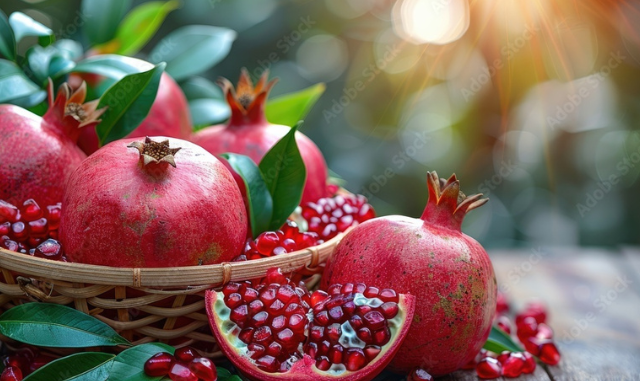
Feel The Power Of Pomegranate
Pomegranate (Punica granatum) is a bush or small tree of the family Lythraceae and its fruit. The juicy arils are eaten fresh, juiced as a source for refreshing beverages or grenadine syrups often used in flavorings and liqueurs. Historically the pomegranate was thought to have originated in Afghanistan and Iran before being introduced being exported to other parts of Africa, Asia and Europe. Later it was introduced to Spanish America in the late 16th century then into California by Spanish settlers in 1769. Pomegranate is widely cultivated throughout Caucasus, West Asia, region, South Asia, Central Asia, tropical Africa, including drier parts of Southeast Asia. and the Mediterranean Basin. The popular fruit is typically in season in the Southern hemisphere from March to May and in the Northern Hemisphere in September and February.
The most sought after part of the pomegranate is the arils ( ruby red juicy coating surrounding the seeds. Arilis are a delicious snack on their own or a great addition to meals. Getting the arils out of the pomegranate is somewhat of a challenge for consumers. Pomegranate juice is claimed to have many health benefits as being high in antioxidants and anti-inflammatory properties. 365 Whole Foods Market Pomegranate Juice is available in a 32 ounce container online or at your local Whole Foods Market. Pomegranate fruit is high in dietary fiber, vitamin C, vitamin K and folic acid. The plant which may attain 5 to 7 meters or 16 to 23 feet in height has an elliptic lance shaped with bright green leaves, ranging about 3 inches long. The attractive axillary orange red flowers are born toward the ends of the branchlets. The calyx, consisting of the sepals, is tubular and persistent.
The edible part of the plant is 78 percent water, 19 percent carbohydrate, 2 percent protein, and 1 percent fat. A 3.5 ounce serving of pomegranate sarcotesta (seeds) provides 12 percent of the daily value of vitamin C, vitamin K, 10 percent foliate. Pomegranate seeds ate a rich source of dietary fiber 20 percent DV which is entirely contained in the seeds. The most abundant phytochemicals in pomegranate juice are considered tannins, catechins, flavonoids, and prodelphinidin compounds. The higher phenolic content of the peel yields extracts for use in dietary supplements and for food preservatives. Pomegranate seed oil contain 65 percent punicic acid a polyunsaturated fatty acid obtained from the seeds, and 5 percent palmitic acid, 2 percent stearic acid, 6 percent oleic acid, 7 percent linoleic acid a polyunsaturated fatty acid essential in the human diet.
Pomegranate juice contains various phenolic compounds including ellagitannins, flavonoids, anthocyanins, and phenolic acids. The total phenolic acid content (TCP) of pomegranate juice can range from 220- 2931 mg/100ml as composition compounds vary depending on the cultivar. Four phenolic compounds were identified and quantitated in studied pomegranate juice are ellagic acid, gallic acid, punicalagin acid A and punicalagin B,” ScienceDirect. Pomegranates are a nutritious fruit rich in antioxidants that can have many health benefits supporting urinary health, may help reduce inflammation, The polyphenol complex of pomegranate peel (Punica granatum L) which makes up half of the pomegranate fruit has more pronounced antioxidant and anti-inflammatory properties than other parts. “ Several studies have shown protective effects of ellagic acid, punicalagin against oxidative stress damage caused by free radicals.
The potential of pomegranate peel as an antioxidant and therapeutic component in various biological systems is high according to scientific sources.” PubMed Central Pomegranate Extract Polyphenols superfood supplement made by Nature’s Craft 500 mg capsules for heart health and joint support Reds superfood powder capsules for Men and women 180 count. Feel the power of pure pomegranate superfruit supplement made from real fruit rich in ellagic acid punicic acid, vitamin C, and CLA conjugated linoleic acid rich in essential fatty acids that promotes sharper memory.
Cheers!
Patricia Lynn
Images Courtesy of MyKitchen at AdobeStock